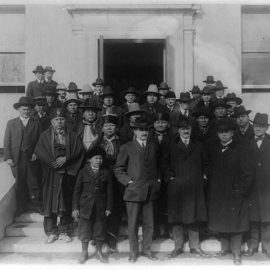

This article is an excerpt from the Shortform book guide to "Hard Times Create Strong Men" by Stefan Aarnio. Shortform has the world's best summaries and analyses of books you should be reading.
Like this article? Sign up for a free trial here.
What’s causing the decline of the traditional family? Why are marriage rates so low and divorce rates so high?
The decline of the family is a real problem in society. According to Stefan Aarnio, as he states in his book Hard Times Create Strong Men, men suffer from the low rates of marriage because it threatens their masculinity.
Continue reading to learn how men are affected by a lack of a traditional family.
How the Decline of the Family Has Weakened Men
Aarnio argues that men have grown weak due to the decline of the family unit. Aarnio asserts that today’s 50% divorce rate is partly due to feminism. We naturally like whoever is opposite us on the energy spectrum; someone with flowing feminine energy is attracted to someone with strong masculine energy (and vice versa). Since women traditionally spent their days in a domestic role, they had high feminine energy—and so were naturally attracted to their husbands who worked outside the home and so had high masculine energy.
But thanks to feminism, women started working. Women who work have higher masculine energy, so they’re more likely to lose their attraction to their husbands and divorce them (since their energies are no longer opposite). Moreover, Aarnio asserts that since men and women are now ostensibly equal, they don’t need each other—and so are less likely to get married in the first place.
| What Others Say About High Divorce Rates and Low Marriage Rates Sociologists and economists propose an alternate explanation for the high divorce rate—which has reduced in the last several decades for college-educated couples. Statistics indicate that the divorce rate peaked in the 1970s and 1980s, and scholars agree that this was partly due to the “new feminist movement.” However, they don’t attribute the high divorce rate of the 1970s and 1980s to the shift in women’s energies and thus their attraction levels; rather, they suggest that this increase resulted from a shift in people’s expectations of marriage. Prior to the 1970s, people married with the expectation that women would stay home and men would earn money. But when women started working en masse in the 1970s, people who’d married prior to this societal movement realized that they had new expectations of marriage (for example, the wives wanted to work too), and this mismatch in expectations led divorce rates to skyrocket. A shift in expectations regarding partnerships may also explain the decline in marriage rates. It’s now socially acceptable for unmarried partners to cohabitate; many of these couples live together and break up without ever getting married (and thus divorced). Additionally, couples tend to get married later because they expect their spouses to provide long-term companionship and are also willing to wait longer for the right person. |
Aarnio adds that government policies and changing social norms have also contributed to the decline of marriage. Women are no longer reliant on their husbands for survival; now, they can easily divorce him and live not just on his assets but those of the government via public assistance programs. Not only does this encourage divorce, it discourages men from getting married because they’re worried that their women will steal their assets. Moreover, people no longer turn to religious leaders or long-married couples for marital advice; instead, they turn to their single friends, who often encourage divorce.
(Shortform note: Some experts agree with Aarnio that American government policies—specifically, the 1996 introduction of Temporary Assistance for Needy Families (TANF)—have contributed to the decline of marriage. However, they don’t state that women are incentivized to divorce their husbands or that men are discouraged from getting married because of the potential financial risk involved. Rather, they point out that TANF discouraged low-income couples from getting married by penalizing them financially—married couples received fewer welfare benefits than single people. Experts also agree with Aarnio that a couple’s social circle raises their risk of divorce, but studies indicate that the risk stems from having divorced friends, not single friends.)
This decline of marriage has weakened men, Aarnio explains, by robbing them of their fathers, who play an irreplaceable role in their sons’ upbringing. Boys who grow up without a father miss out on the opportunity to learn about male-female relationships (by watching their parents) and so are more likely to struggle with their sexuality. They don’t learn how to be masculine and instead are forced to learn about it from other sources (like Aarnio’s book).
Moreover, in many households, fathers are the disciplinarians who punish sons for their bad behavior. Aarnio argues that without dads around, sons grow used to getting their way without any consequences and so are more likely to break the law and land in legal trouble.
| What Studies Say About the Impact of Absent Fathers Some scholars support Aarnio’s contention that there is a relationship between boys with absentee fathers and homosexuality. Several researchers in the early 1900s found that many gay men grew up with dominant mothers and uninvolved fathers. However, researchers don’t agree that boys with absent fathers become less masculine. Rather, studies suggest that boys with absent fathers identify more with the feminine gender identity, and so they rebel against this by engaging in more masculine behavior. Studies also support Aarnio’s contention that disciplinarian fathers have a significant impact on their children long-term. Research indicates that fathers discipline their kids with the intention of teaching their kids how to behave long-term in society, and this discipline has a bigger impact in later life. This may explain why fatherless sons have a delayed reaction to the lack of discipline by acting out as adults and landing in legal trouble. |

———End of Preview———
Like what you just read? Read the rest of the world's best book summary and analysis of Stefan Aarnio's "Hard Times Create Strong Men" at Shortform.
Here's what you'll find in our full Hard Times Create Strong Men summary:
- Why modern Western men are weak, leading to civilization decline
- How to be a strong man at work and in relationships
- Why pickup artistry doesn't lead to fulfilling relationships






